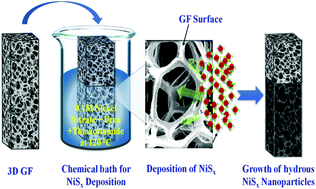Hydrous nickel sulphide nanoparticle decorated 3D graphene foam electrodes for enhanced supercapacitive performance of an asymmetric device†
Abstract
Hydrous nickel sulphide is successfully synthesized on graphene foam (Ni9S8/GF) using a facile chemical bath deposition (CBD) method. The physico-chemical properties (XRD, RAMAN, FE-SEM and TEM) show that hydrous nanocrystalline Ni9S8 particles are uniformly distributed over the surface of multilayered graphene foam (MGF). The electrochemical capacitive measurement results reveal that the Ni9S8/GF 3D porous electrode exhibits high specific capacitance of 2055 F g−1 at 2 A g−1. Moreover, an asymmetric supercapacitor fabricated using the Ni9S8/GF electrode as the positive electrode and activated carbon (AC/NF) as a negative electrode shows a high energy density of 51.11 W h kg−1 at a power density of 2.66 kW kg−1. The enhanced capacitive performance of an ACS device can be attributed to the introduction of Ni9S8/GF, since 3D GF offers a porous structure with high specific surface area and continuous conducting structure, which possesses more active sites for charge storage and assists fast charge transport through the continuous 3D graphene structure.



 Please wait while we load your content...
Please wait while we load your content...